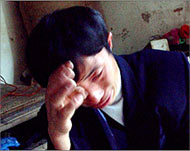How the dragon is chasing AIDS
It is a great, gaping toothless grin but the fact that this old woman can smile is a miracle in itself.

Moments earlier she had been hunched over her desk putting the final touches to a piece of artwork that is now being admired by all the rest of the art class.
But this is no ordinary classroom and the would-be artists are no ordinary students.
They are being made to confront their fears and prejudices by pouring out their emotions on canvas.
The students are just some of China’s aids sufferers, but instead of being shunned by society the government is trying to deal with the growing problem it can no longer ignore.
The classroom project is just one example of how China is trying to cope with one million AIDS/HIV sufferers but according to UN expert that figure could increase to 15 million by 2010.
The art class is being supervised by Jose Abad, the initiator of this project called Positive Art … a groundbreaking experiment in using art as a medium to interact with China’s HIV/AIDS patients.
Except for the two foreign instructors, everyone in the class is either HIV positive or suffering from AIDS. Coming from across the country to receive free medicine, their artwork gives a human face to a problem the Chinese government has only recently began to acknowledge.
The scale of the problem
|
“The door of opportunity is still open but I fear it will shut soon. We must take the opportunity now to do something” Professor Shao Yiming, |
“The door of opportunity is still open but I fear it will shut soon. We must take the opportunity now to do something,” Professor Shao Yiming, Chief Expert at the National Centre for AIDS Control and Prevention, warns visitors as he guides them around his laboratory-testing centre.
Until 2001, the government refused to admit there was a HIV/AIDSproblem in China. In that year, however, an official statement issued declared the presence of approximately 600,000 cases. This year the figure has gone up to at least one million HIV/AIDS cases.
The UN recently announced a projected figure of between 10-15 million cases by 2010, a figure that is conservative, by some estimates, and would put China on a footing with Africa and India in terms of AIDS numbers.
The signs are all pointing to an explosion in the number of new cases as the disease is transferred from those most at risk; intravenous drug users, prostitutes and blood donors, into the population at large.
From the first reported case in 1985 the disease appeared to begin among both foreign workers in major cities and drug users/traffickers in Southwestern Yunnan province.
From there, the disease was spread along drug routes into Central China and by the tens of millions of migrant workers, many of whom use prostitutes, as they criss-cross China looking for work.
The most infamous series of cases, though, have been in relation to the blood donation schemes run by local governments during the mid 1990s.
These were targeted at rural areas where impoverished farmers were willing to give blood regularly in return for cash, roughly 2000 RMB, ($250) a year.
Blood was often taken from several people using unsanitary equipment, mixed together while plasma was removed, and then re-injected back into the unwitting donors, rapidly passing on blood born diseases.
 |
|
A Chinese man informed that |
These so-called ‘aids villages’ have become a symbol of the plight of HIV/AIDS sufferers. Located in centrally placed Henan province, they remain cut off from the outside world, with access rarely granted even to AIDS workers.
The central government has promised to set aside funds for constructing local clinics and providing free medicine, a promise, village members say, that is yet to be fulfilled.
In recent months, the villages made the news again after police raids in response to a series of violent clashes between local authorities and village members over the failure of funds to materialize.
Reports of beatings and subsequent arrests made headlines worldwide, as Human Rights and AIDS activists were quick to condemn the local governments’ behaviour.
Dealing with HIV/AIDS
The failure of the police and local authorities in Henan to take the matter seriously underlines a more pervasive question of how HIV/AIDS is perceived in the society at large.
Dr Chen, of the Hong Kong International Medical Clinic, summed it up, “most people don’t know about aids. If you have aids, other people will look down upon you thinking you must be a drug addict, homosexual or a prostitute.”
There is a need for the issue to be taken more seriously, added Shao Yiming, “local leaders do not consider aids a threat, they are not paying it enough attention”.
Surveys carried out by both the Chinese government and outside bodies point to a widespread ignorance of the disease, creating both an enhanced risk of contraction and increased stigma for those already infected.
A December 2000 survey conducted by the government revealed that one in five was unaware of aid’s existence and about 50% did not know HIV could be sexually transmitted.
A secondary study by the UN in 2002 revealed two thirds of Beijing middle school children thought mosquitoes could transmit the disease and over half those questioned did not realise condoms could help prevent transmission.
UN report 2002 |
Jose Abad’s experience echoes these survey results. “For almost all, this classroom is the only place they are able to talk freely about AIDS, the rest of society is closed to them.”
To combat this situation, last winter saw the first sex education classes in the nation’s middle schools as well as a lifting of the ban on condom advertising.
Professor Shao, though, confides that, as an issue, there are huge cultural barriers to overcome, particularly in regard to discussing sex openly among both children and adults. He also cautions against optimism and lambasts the media for only giving the issue front-page attention on World aids Day on 1 December .
“I don’t think anyone can change this quickly but we must address these cultural issues now. We must halt further ostracism of people by their peers.”
Song Pengfei, a campaigner for HIV/AIDS awareness, echoes this belief. Song is himself HIV positive after undergoing an operation using contaminated blood when aged 15.
“For the most part, aids patients have no money, no medicine and no understanding of what aids is. I am lucky to have friends and family who support me”, a situation, Song says, many HIV/aids patients are denied.
Additional efforts
 |
|
A Chinese laboratory worker |
The government, for its part, has made a number of recent changes.
Resisting internal pressures on the promotion of condoms and clean drug use as being tantamount to condoning sex and drug use, the government instituted a five-year plan from 2001-2005 to deal with the threat.
This plan has seen 100 million RMB ($12.5m) injected yearly into creating a national infrastructure capable of dealing with HIV/AIDS.
Pilot projects are being tested with an emphasis placed on education in workplaces and schools, better medical care and counseling services for those infected and their families.
The government has issued targets of reducing the growth rate of news cases to 10% of existing cases, as opposed to the current figure of 30%.
Whether the five-year plan will help while the door of opportunity is still open remains to be seen. During the recent SARS crisis, the government showed that it has the ability to launch a nationwide health and awareness campaign within a short frame of time.
“HIV education is only at the beginning”, cautions Dr Chen, “but we must talk about it on the table, not under it.”